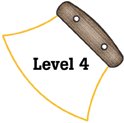
Alaska Science
Key Element D2
 |
Alaska Science |
|
Performance Standard Level 4, Ages 15–18
|
|
|
|
Sample Assessment Ideas
|
|
|
Expanded Sample Assessment Idea
|
|
Procedure Students will:
Reflection and Revision
|
Levels of Performance |
||
|
Stage 4 |
Student uses both primary and secondary sources in researching nuclear power facilities. Student waste storage strategy shows evidence of higher-order thinking and is elaborate. | ||
|
Stage 3
|
Student uses either primary or secondary sources in researching nuclear power facilities. Student waste storage strategy shows limited evidence of elaboration or higher-order thinking and may contain minor errors or inaccuracies. | ||
|
Stage 2
|
Student uses minimal information to research nuclear power facilities. Student waste storage strategy is incomplete and may show errors of scientific fact, inaccuracies or misconceptions. | ||
|
Stage 1
|
Student relies on previous knowledge or biased opinions to collect information about nuclear power facilities. The storage strategy lacks adequate detail and shows evidence of serious misconceptions. | ||
Standards Cross-References
|
||
|
National Science Education Standards Understanding basic concepts and principles of science and technology should precede active debate about the economics, policies, politics, and ethics of various science and technology related challenges. However, understanding science alone will not resolve local, national or global challenges. (Page 199) Individuals and society must decide on proposals involving new research and the introduction of new technologies into society. Decisions involve assessment of alternatives, risks, costs, and benefits and consideration of who benefits and who suffers, who pays and gains, and what the risks are and who bears them. Students should understand the appropriateness and value of basic questions “What can happen?” “What are the odds?” and “How do scientists and engineers know what will happen?” (Page 199) |
Benchmarks Technology usually affects society more directly than science because it solves practical problems and serves human needs (and may create new problems and needs). In contrast, science affects society mainly by stimulating and satisfying people’s curiosity and occasionally by enlarging or challenging their views of what the world is like. (Page 47) In deciding on proposals to introduce new technologies or to curtail existing ones, some key questions arise concerning alternatives, risks, costs, and benefits. What alternative ways are there to achieve the same ends, and how do the alternatives compare to the plan being put forward? Who benefits and who suffers? What are the financial and social costs, do they change over time, and who bears them? What are the risks associated with using (or not using) the new technology, how serious are they, and who is in jeopardy? What human, material, and energy resources will be needed to build, install, operate, maintain, and replace the new technology, and where will they come from? How will the new technology and its waste products be disposed of and at what costs? (Page 57) |
|
Table of Contents | Return to Alaska Native Knowledge Network